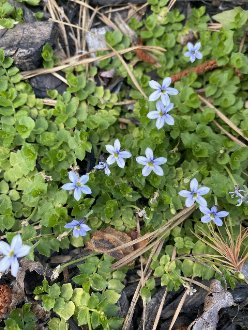Blue Star Creeper (Lobelia pedunculata R.Br.)
Also known as matted pratia, trailing pratia; also classified as Pratia pedunculata (R.Br.) Benth.
↑Range - Expand
| Legend | Color |
| Introduced |
This map is based on our research. We have checked its accuracy to Level 4 ecoregions. Although this plant occurs somewhere in each of these regions, it may only occur in a small part of some or all of them.
This species is native to eastern Australia; it is occasionally planted in landscaping. It has been reported establishing in the wild only at one location in Bandon, Oregon, but it may be underreported. iNaturalist shows many records that seem to be at least garden-persistent, and gardeners often report it as a nuisance plant due to its spread and difficulty in removing it.
↑Uses
This species has been planted as a landscaping plant.
We strongly urge against planting it as it has already established in the wild and may have invasive potential in multiple regions.
↑Notes
We recommend against the common names "matted pratia" and "trailing pratia" because they reference the genus Pratia, which this species has sometimes been classified in. The current consensus, however, classifies it in the Lobelia genus, so these common names can be misleading. In general we prefer common names that are not exactly the same as a scientific genus specifically because the name can become confusing or misleading if or when the plant is reclassified. The common name "blue star creeper" is descriptive because this species has a creeping habit and blue, star-shaped flowers.
↑Links & External Resources
• Lobelia pedunculata | Biota of North America Project (BONAP) (About This Site)
• Lobelia pedunculata R.Br. | Plants of the World Online (POWO) (About This Site)




